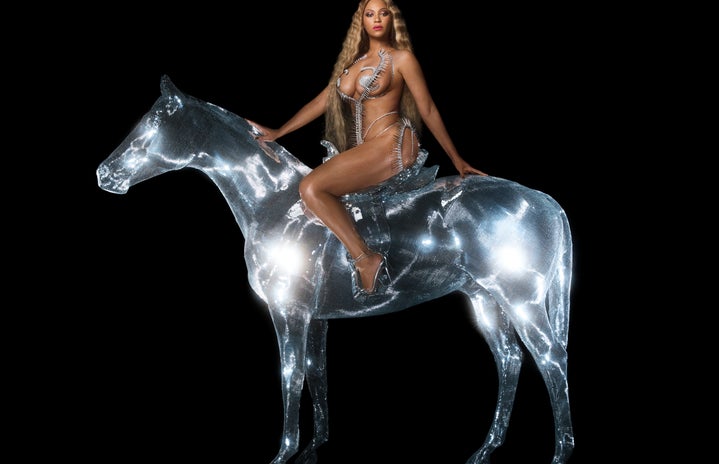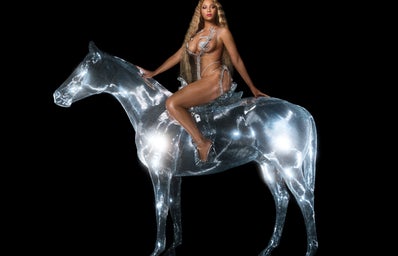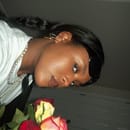On Nov. 30, the day of the Renaissance: A Film by Beyoncé early screening, less than 100 people, including myself, sat to watch a film documenting one of the highest-grossing tours of all time. Immediately the BeyHive, Beyoncé’s huge fanbase, acted as if they were family or had been friends for years.. That’s why, as soon as I entered the AMC theater in East Village, I felt like I knew everyone there. There was an unspoken agreement that we would all have fun, whether we were cheering, crying, dancing, or singing. The sole common denominator between us all was us loving Beyoncé, her music, and what she stands for; we were a community. Beyoncé and her music, as she perfectly displayed in the film, “bring people together.”
Renaissance: A Film by Beyoncé wasn’t just a film of Beyoncé singing songs from her tour; it was a glimpse into her personal life, a trip down memory lane, a sense of camaraderie and family, and an appreciation for everyone who made the tour possible. One thing that I realized I’d neglected after I’d seen the film, was the stage itself. The stages are truly intricate pieces of machinery that can take anywhere from hours to a day to build. Beyoncé made it a large point in the film to highlight just how many people and how much effort it takes to rebuild and take down those sets. As a member of the audience at the Washington D.C. second show in August, I hadn’t thought about every part of the screen being placed by hand or how unique the lighting was during each song and era. Beyoncé was so emphatic about how much she appreciated and cared for her stage crew, from lighting to sound to building sets, they all made the show possible.
Beyoncé dances, sings, and connects with the crowd throughout each show of the Renaissance Tour, but most people don’t know that she is also a director. Beyoncé didn’t have close to 50 days off, working tirelessly to bring her vision of the Renaissance era to life. She worked closely with lighting, one of her favorite parts of the performance, to create an effortlessly engaging and never-before-seen show. She was at every rehearsal, and every meeting with choreographers, and even formed an entire group just for this tour. Pure Honey is the name of the girl band that includes Beyoncé’s beautiful backup singers who have their own part in the show. Beyoncé was the director and coordinator of every aspect of the Renaissance tour, as she was also the main attraction. Choreographers, dancers, stage crew members, and everyone else who made the Renaissance possible said that they were a family and that Beyoncé had a vision and it was their job to execute it. Of all the roles she plays, there’s one that is most important to her. This role never stops, even after the lights go off and all the fans exit the stadium. Beyoncé’s number one priority in her life is her family, more specifically her love of being a mother.
It was stated several times that the Renaissance tour was “also a renaissance for Blue Ivy.” Beyoncé prioritizes her children and family over all work, so when Blue Ivy said she wanted to dance on stage with her she said no. For her safety and well-being, she told her that she was not old enough. After asking and begging many times over, Beyoncé finally gave in, only requesting that Blue earn her spot as a dancer on tour through auditioning and working closely with the other dancers and choreographers, just as anyone else would. Many parts of the film feature Blue’s life growing up on tour, her being hated and mocked by the public from birth just because she was born into her parents’ lives of fame, and her gaining confidence every time she performed. The transformation of Blue Ivy was considered her own personal renaissance. It’s important to note that renaissance, by definition, simply means a rebirth or revival of something. Beyoncé felt it was fitting for Blue to join her onstage to dance during her songs “MY POWER” and “BLACK PARADE” due to the meaning behind the songs. They have an extremely powerful theme, including the power and importance of black excellence. Blue, although shy and timid at first, grew more and more confident in both herself and her dancing. Suddenly, the hate comments surrounding Blue Ivy’s confidence, or lack thereof, turned into proud moments of praise and love from strangers throughout the internet.
As people came together to praise Blue and Beyoncé, we also praised and loved each other. Beyoncé’s music as a whole, but specifically in Renaissance, is about self-love, joy, community, black excellence, and acceptance. People came from far and wide to sing and dance along with other Beyoncé fans. The theme of Renaissance being monochrome silver, the representation of the BeyHive through Beyoncé’s outfits, and messages in the song inspired widely unique and beautiful outfits in every stadium. Dress code became a serious aspect of the Renaissance era that brought people together and displayed the idea of self-expression through clothing. Beyoncé, an extremely fashionable and inspiring person in the industry, shared her appreciation of clothing and how it makes her feel through an entire moment of the film being dedicated to the fans’ fashion at her shows and her fashion icon, Uncle Johnny. Uncle Johnny, who is mentioned twice in the song “HEATED,” was an openly gay family friend. He made most of Beyoncé’s and the other members of Destiny’s Child’s clothes due to most brands not wanting to sponsor three black women in the ‘90s. Renaissance paved a new way of fashion at concerts; self-expression is key in Beyoncé’s house and was even present in the theater during the film screening.
Renaissance: A Film by Beyoncé was such a special experience for me, both in person and through the screen. The feeling of sheer happiness with a large group of people who all love the same person for the same reason was irreplaceable. The dance routines from the tour being done by fans in the back, the experience of Beyoncé’s new song titled “MY HOUSE” being played for the first time during the credits scene, and seeing the smiling, crying faces staring up at something they adore on the big screen. Beyoncé creates a perfect environment for everyone to feel calm, appreciated, loved, and free; it feels like a home for all. If you find yourself at any cinema, whether a Beyoncé fan or not, it’s worth your time, money, and effort to go see the Renaissance: A Film by Beyoncé.


